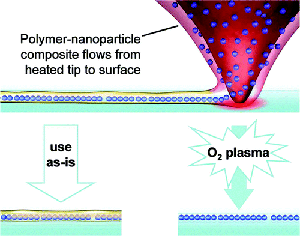| Lee et. al. demonstrated a maskless, additive approach for direct writing of a range of NP–polymer compositions using thermal dip-pen nanolithography (tDPN). This technique represents a facile strategy for deposition of a wide range of NP composite materials in order to create dense nanopatterned films. |
Reviewed by Jeff Morse, Ph.D, National Nanomanufacturing Network
Controlled nanoparticle (NP) assemblies have a range of applications for electronics, optical devices, and sensors. While NP positioning with atomic force microscope tips has been demonstrated to provide extreme accuracy, patterning rates are not viable for high rate nanomanufacturing. Particle driven and templated assemblies of NPs provide an additional means of creating precision NP compositions, but require custom chemistries for each NP material and compositional makeup or a templated patterning to facilitate assembly. Furthermore, the overall fabrication becomes quite complex as chemistry, patterning, additive, and subtractive process steps must be integrated, with each step increasing the probability for cross contamination of the composite matrix or degradation of the NPs.

Recently, Lee et. al. demonstrated a maskless, additive approach for direct writing of a range of NP–polymer compositions. In this work, the authors investigated the controlled assembly of the NP and NP-polymer composites by adjusting tip temperature and speed. In order to demonstrate the versatility of this approach, several materials compositions were investigated, including poly(methyl methacrylate) (PMMA) with Fe2O3 NPs, polyethylene with CdSe/ZnS quantum dots, metallorganic tris(8-hydroxyquinolinato)aluminum mixed with the piezoelectric polymer P(VDF-TrFE), and Au NPs mixed with the undoped conductive polymer PDDT. The authors achieved direct write line-widths of the NP-polymer composites on the order of 100nm. In order to obtain NP patterns, the polymer matrix was selectively removed using an oxygen plasma etch step. As an example, after removal of the PMMA matrix, it was observed that the remaining Fe2O3 NP trace was significantly narrower than the original composite pattern, in this case the pattern was reduced from 360 nm to 10 nm in width. Thus NP concentration or focusing is possible.
In order to better understand and possibly control the NP focusing effect, the authors suggested that the critical balance between NP diffusion and shear flow as the particles are dispersed enables the concentration and alignment for NP assembly. The effect would ultimately have dependencies on solution chemistry, NP size and functionality, and solution viscosity, which could be controlled in part by tip temperature and write speed. The authors demonstrated that write speeds of ~200 µm/sec for polymer blends, but only <2 µm/sec for NP-polymer composites. This technique represents a facile strategy for deposition of a wide range of NP composite materials in order to create dense nanopatterned films. The process has further demonstrated critical features of 10nm for patterned NPs exploiting the shear flow focusing effect, and 78 nm for as deposited NP-polymer composites. This approach further provides a complimentary tool for more complicated integration approaches incorporating top down and bottoms up processes.
Image reproduced with permission from Lee WK, et. al. 2009. Maskless Nanoscale Writing of Nanoparticle-Polymer Composites and Nanoparticle Assemblies Using Thermal Nanoprobes. Nano Letters 10(1): 129-133. DOI: 10.1021/nl9030456. Copyright 2009 American Chemical Society.
This work is licensed under a Creative Commons Attribution-NonCommercial 3.0 Unported.
